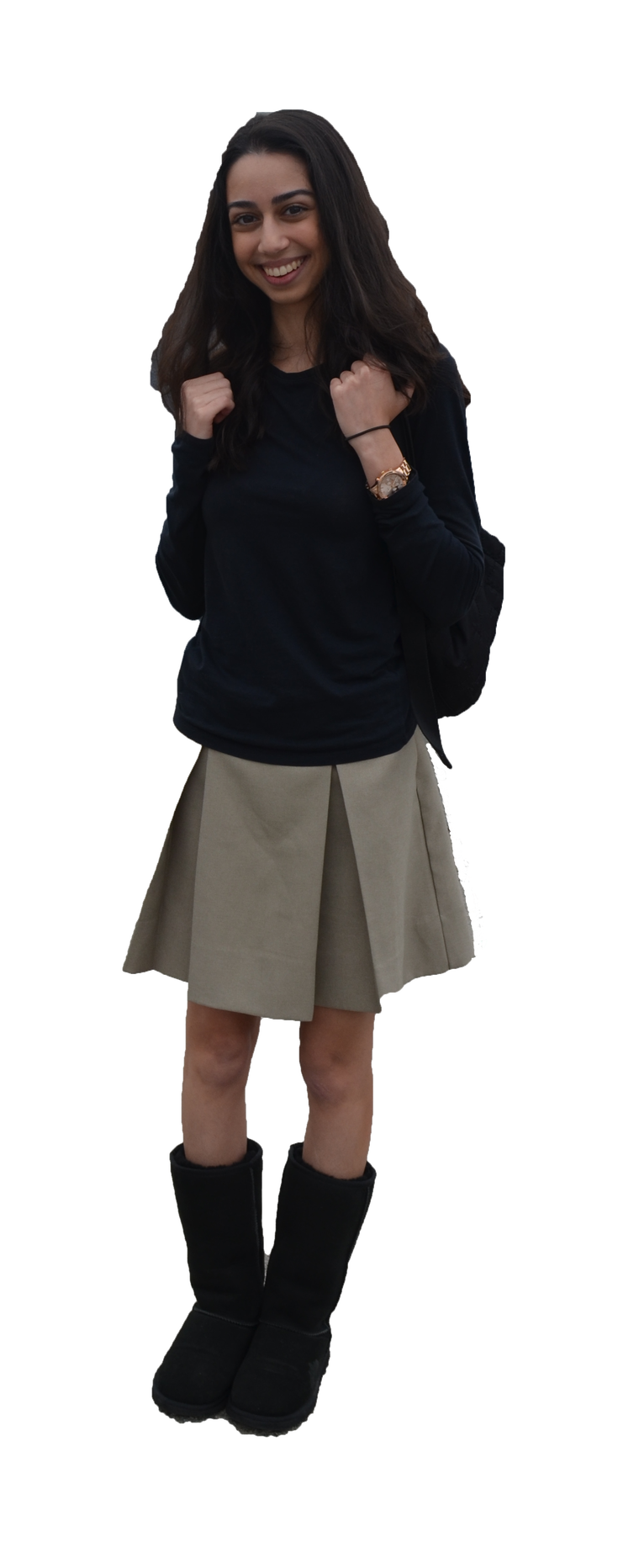TWO BOILING POINTS OF VIEW: Should Shalhevet have a uniform?
January 10, 2014
No, clothing is a form of expression
 By Benny Balasz, Staff Columnist
By Benny Balasz, Staff Columnist
Uniforms have no place in Shalhevet. The one and only Jewish school whose main purpose is to help students form their own identities cannot be one with a uniform dress code. Clothing is one of many ways that students express themselves within our campus, and should be no lesser a canvas than anything else.
As we know, albeit on some days more than others, there is always something a bit more lively and heartwarming about wearing pink jeans, or pajamas under skirts, or flip-flops, or slippers, or a Hawaiian T-shirt. All these small details in our wardrobe add multitudes of color and character to the grounds and to our days.
Switching to uniforms would take this away, and would weaken the now fiery morale of the student body. There are those that argue the point that uniforms would actually improve morale by removing any biases or judgments based on those whose wardrobe reflects an inability to “fit in”, but if kids can be picked on about clothing they wear, those who do so would simply find something else to tease about. Kids are unfortunately very creative when it comes to teasing and judging others by means of hair style, odor, height, weight, maybe even the whiteness of their teeth would soon follow. A uniform won’t stop them.
Some other considerations: why not take into account the fact that parents would now have to pay for a whole new set of clothing for their kids, aside from what they already own? I have read accounts of people who have had to purchase very costly sets of uniforms for their children, which would now go alongside their costs for clothing outside of school. Required clothing can be very pricey, because companies don’t compete; a supplier is chosen and can set whatever price it likes.
It also takes some trouble to keep up with trends and buy new clothes to fit whatever is in season. But neither path is significantly more cost-effective than the other.
Another argument I’ve heard is that uniforms improve work ethic and academic achievement, but I did some research prior to writing this. In 2004, The School Uniform Movement and What It Tells Us About American Education, written by David Brunsma, analyzed two massive databases on the subject, spanning from 1988 to the time of its publication, and concluded that there was no evidence to suggest any academic improvement based on uniform alone.
If Shalhevet is the most promising place for a student looking to become an individual, why would we introduce a system that would gnaw away at one of the most crucial staples in the school’s reputation, namely individuality? We might as well take away Town Hall, and Agenda Committee, and Fairness Committee, and all the other groups, clubs, and school functions that allow us as students to grow and mold into shining individuals.
The reality is that clothing plays a massive role at any point in your life, whether in a high school setting or in a job interview or a fancy dinner. The first thing people do when they meet someone is look at what their wearing, and that is usually an indicator for a lot of things about that person, including their interests, their favorite color, and maybe even their sense of self-confidence.
Finally, if students adhere to a bland protocol in dress, they will lose the ability to be self-conscious. Self-consciousness is actually a good thing. We want students to be aware of themselves because that way they can improve, adapt and figure out who they are in an environment where they feel safe. It’s not our job as a school to resolve those issues; rather it’s their job as individuals to fail and succeed and try time and again. As Rabbi Segal once said, “We are not afraid to fail,” and he couldn’t be more correct.
Shalhevet is truly not a place for a uniform, and rather should be encouraging students to be more creative with their wardrobes, so as to make stronger and more vibrant people who can take that energy into their futures. The entire basis of life in Shalhevet is to be who you are, and not to be some standardized model — it’s to express yourself by any means. Where better to start than in your closet, and in the mirror, every day.
Yes, uniforms mean stress-fre
By Sarah Soroudi, Editor-in-Chief
Throughout grades nine to 12, school completely occupies our thoughts and our lives, and the last thing we want to be worried about in the morning, after getting only four hours of sleep and having to think about two AP tests that day, is what to wear.
Shalhevet is known for its environment: a comfortable place, where the students and teachers are unconditionally accepting and value one another for their unique qualities – not how they dress. Several years ago, wearing blankets to school was the fad, and slippers are still worn in the wintertime, viewed the same way as a pair of Converse.
A mandatory school uniform, perhaps with a few choices – two different patterns for the skirts, and two or three different colors for shirts and tops – would solve several big problems, while still letting us be the unique people that we are.
For as long as I can remember, mornings at Shalhevet have been a time of worry. The eternal question running through students’ minds is “Are they on alert today?” Every morning, the administration stands out in front of the school and greets every student as he or she arrives.
Whatever other reasons they may have for doing this, they also at that moment scan the student’s outfit to see if any part of it is out of dress code. If it is, he must either change, go home or buy or borrow? new and appropriate clothing from the school.
A uniform would put an end to this, removing moments of stress and humiliation and – as we hear whenever the subject comes up — a part of the job that faculty and staff members really don’t like. It would also mean more room in students’ lockers, by allowing the girls to finally bring home their “safe skirts” that they have been stashing away in case of emergencies.
Individuality would in no way decline with a uniform – if anything, a heightened focus on socks and scarves would spur a movement that screams individuality.
Students in middle schools with uniforms have figured this out. Drive by any of these schools at carpool time. What catches your attention as much as their roller-backpacks are the knee-length, neon socks the girls are wearing, the how different all the kippahs are, and the sweaters both boys and girls wear over their collard shirts. Anyone who lays eyes on these students guess where they like to shop, what their style is, and maybe even what their personality is like.
And to the many students who cannot add picking out an outfit to their list of things to get done, a uniform is a blessed one less thing to think about.
The argument that having a mandatory uniform strips students of their right to express themselves through their appearances is not valid. Students could accessorize the uniform to their hearts’ content, and show their creativity that way. Shoes, jackets, scarves and socks are only a few of the possibilities. A uniform with more than one choice would provide multiple combinations and keep everyone from looking the same.
Uniforms would also help the administration with their never-ending mission to keep students in dress code, which they consider important to create a respectful atmosphere at school. A set uniform cannot ensure skirt lengths, but it can prevent girls from wearing skirts that are too tight, shirts that are see-through or have too low of a neckline, and boys from wearing blue jeans and non-collared shirts.
As for the cost, paying for three uniforms would probably total far less than all the clothes students buy for high school just for variety. There would be an upfront cost, but it would be a small price to pay for the benefits ultimately enjoyed.
Done the Shalhevet way, with a little bit of choice and lots of creativity and flair, a uniform could be the next best thing to happen to Shalhevet since the Town Hall, Agenda and Fairness – and a win for every individual, whether in slippers, sneakers or a blanket.
